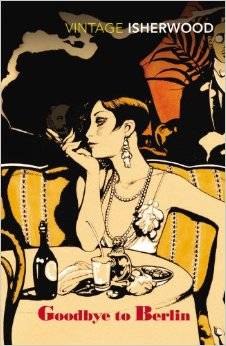„Goodbye to Berlin, London“ von Christopher Isherwood (englisch)
rezensiert von Lucia Höfer, 11. Klasse Lichtenbergschule, Darmstadt

The Weimar Republic of the early 1930s is remembered as a time of flappers, cabaret and decadence, but also as one of simmering political unrest and street brawls. British author Christopher Isherwood spent some years in Berlin and summarized his experience in the novel “Goodbye to Berlin” published in 1939. As an observant first-person narrator, he paints a picture of the different people he encounters.
Isherwood, who is called “Herr Issyvoo” by his German acquaintances, lodges with a ragtag group of Berlin bohemians. He makes a living by teaching English to rich children, such as the obnoxiously sympathetic Hippi Bernstein.
In a cabaret theater, Isherwood meets the 19-year-old Sally Bowles, fellow countrywoman and untalented, yet ambitious singer. Her efforts to become a celebrity or, as a plan B, marry a rich man put herself and Isherwood through numerous complications. Finally, she disappears without a trace, much to the narrator’s chagrin.
During his holiday on Rügen Island, Isherwood encounters Peter, a fellow countryman with slight neuroses and Otto Nowak, a factory workers’ son in his late teens. The unlikely duo is good friends and may even have a homosexual relationship. Due to the heteronormative standards of his time, however, the author does not specify this. A carefree time spent with water sports, talking and relaxing on the Baltic beaches ensues. Yet the sinister reality catches up in shape of the swastika flags children put on their sandcastles, evidence of fascist propaganda seeping into every stratum of personal life.
Invited by the Nowaks to lodge at their home, Isherwood witnesses the poverty and squalor in which the working-class Otto is forced to live in. Familial relations are damaged. The Father, a veteran of World War I, is an alcoholic, while Otto’s brother has joined the NSDAP in a desperate effort to climb the social ladder. Yet Otto remains an enthusiastic and hopeful member of the Communist underground to which he introduces Isherwood.
The portrayal of the cousins Nathalia and Bernhard Landauer sets the darker tone for the rest of the story. Both attempt to shrug off the impending Nazi threat they have to face as Jewish citizens. This results in Bernhard getting murdered by the SA, an incident the newspapers report unconvincingly as a ‘heart attack’.
Finally, the narrator decides to leave the city. The ending seems ominous in hindsight, set on the eve of the Second World War. Pushed more than ever to the fringe of society by the new government, it is hinted that an unhappy future awaits the Berliners.
I found the novel to be vividly written. However, I would not recommend it to readers looking for an action-packed or highly romantic work. The characters’ stories are realistic, believable and fit wholly into the slice-of-life genre.
The novel’s strong point is evident in the description the narrator gives of Hippi. She “refers continually to the political situation”, yet still it is “quite unreal to her”. She wants to “go to university, travel about, have a jolly good time.” (p.29). Individuals, and not a time period act as protagonists. The resulting read is very unlike that of a history book, which focuses on the decisions of statesmen and treats large parts of a population as more or less homogenous masses. I was left to wonder how these people from roughly 85 years ago are indeed not so different from us.
Text von Lucia Höfer, 11. Klasse Lichtenbergschule, Darmstadt
geschrieben am: 23. Juni 2015 unter der Betreuung von Margit Sachse



